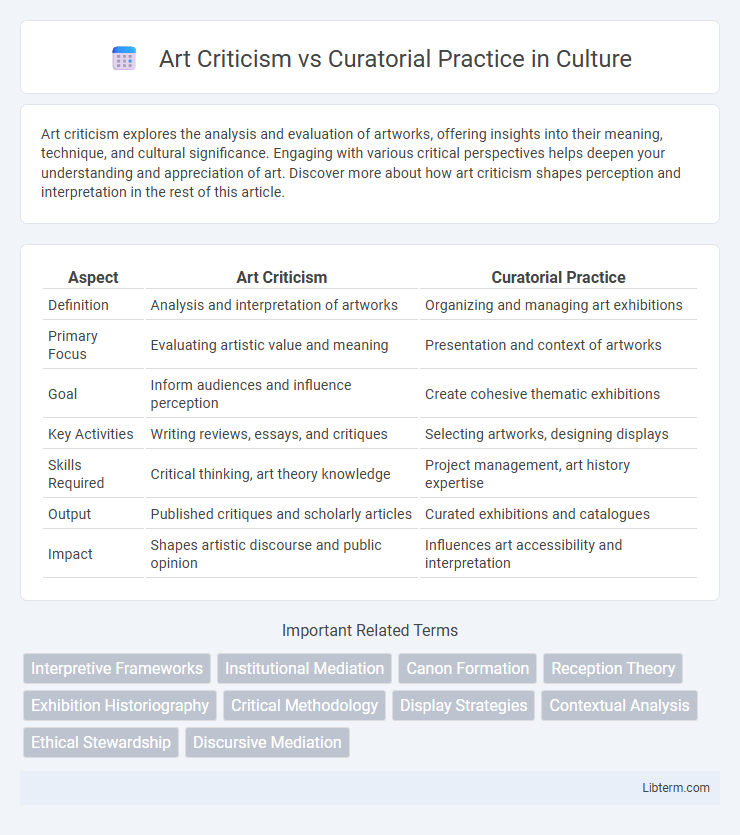Art criticism explores the analysis and evaluation of artworks, offering insights into their meaning, technique, and cultural significance. Engaging with various critical perspectives helps deepen your understanding and appreciation of art. Discover more about how art criticism shapes perception and interpretation in the rest of this article.
Table of Comparison
| Aspect | Art Criticism | Curatorial Practice |
|---|---|---|
| Definition | Analysis and interpretation of artworks | Organizing and managing art exhibitions |
| Primary Focus | Evaluating artistic value and meaning | Presentation and context of artworks |
| Goal | Inform audiences and influence perception | Create cohesive thematic exhibitions |
| Key Activities | Writing reviews, essays, and critiques | Selecting artworks, designing displays |
| Skills Required | Critical thinking, art theory knowledge | Project management, art history expertise |
| Output | Published critiques and scholarly articles | Curated exhibitions and catalogues |
| Impact | Shapes artistic discourse and public opinion | Influences art accessibility and interpretation |
Defining Art Criticism and Curatorial Practice
Art criticism involves the analysis, interpretation, and evaluation of artworks, focusing on aesthetic, cultural, and historical contexts to provide informed judgments. Curatorial practice centers on selecting, organizing, and presenting artworks within exhibitions, shaping the narrative and reception through thematic and spatial decisions. Both disciplines engage deeply with art but differ in their objectives: criticism evaluates art's meaning and impact, while curatorial work facilitates viewer experience and art accessibility.
Historical Evolution of Both Disciplines
Art criticism and curatorial practice have evolved distinctly since the 18th century, with art criticism emerging as a means to evaluate and interpret artworks through influential figures like Denis Diderot and later Clement Greenberg shaping modern discourse. Curatorial practice developed alongside museums and galleries, transitioning from mere collection management in the 19th century to dynamic exhibition design and audience engagement in contemporary art institutions. The historical evolution of both disciplines reflects a shift from passive observation to active mediation, with curators increasingly influencing interpretation while critics maintain a key role in contextualizing artistic value.
Core Objectives and Responsibilities
Art criticism centers on evaluating and interpreting artworks to provide deeper understanding and cultural context, often influencing public perception and artistic discourse. Curatorial practice involves selecting, organizing, and managing art exhibitions to create coherent narratives and enhance audience engagement with the collection. Both roles are essential in the art world, with critics focusing on analysis and interpretation, while curators emphasize presentation and preservation of artworks.
Methods of Art Interpretation
Art criticism employs analytical methods such as formal analysis, iconography, and contextual evaluation to interpret artworks by examining elements like composition, symbolism, and historical background. Curatorial practice focuses on thematic curation, spatial arrangement, and audience engagement strategies to create meaningful narratives within exhibitions. These interpretive methods shape the understanding and presentation of art, influencing both scholarly discourse and public experience.
Audience Engagement Strategies
Art criticism engages audiences by providing interpretive frameworks that deepen understanding and provoke emotional and intellectual responses to artworks. Curatorial practice emphasizes audience engagement through immersive exhibitions, interactive installations, and educational programming that foster participatory experiences. Both disciplines utilize targeted communication techniques and contextual storytelling to connect diverse audiences with art in meaningful ways.
Influence on Artistic Trends and Movements
Art criticism shapes artistic trends by offering interpretive frameworks that challenge and expand creators' perspectives, fostering innovation across movements. Curatorial practice influences these trends through contextual presentation and thematic exhibitions that highlight emerging artists and reframe established narratives. Together, these disciplines drive the evolution of contemporary art by mediating dialogue between artists, audiences, and cultural institutions.
Collaboration with Artists
Collaboration with artists in art criticism emphasizes deep dialogue and interpretation to enrich understanding and contextualize artworks. Curatorial practice prioritizes partnership with artists to co-create exhibitions, ensuring that the presentation aligns with the artist's vision and engages audiences effectively. Both disciplines value collaborative approaches but differ in their objectives: criticism seeks critical analysis, while curatorship aims for experiential and spatial realization.
Professional Skills and Training Required
Art criticism demands strong analytical skills, in-depth knowledge of art history, and the ability to articulate interpretations clearly through writing. Curatorial practice requires expertise in collection management, exhibition design, and project coordination, often supplemented by training in museum studies or cultural management. Both professions benefit from formal education, hands-on experience, and continuous engagement with contemporary art trends.
Ethical Considerations and Challenges
Art criticism demands rigorous ethical standards to ensure unbiased evaluation and respect for artistic intent, while curatorial practice grapples with the challenge of balancing public accessibility and the preservation of cultural heritage. Both fields confront issues such as intellectual property rights, cultural appropriation, and the representation of marginalized voices, requiring ongoing ethical reflection and transparent decision-making. Navigating these complexities is essential to fostering inclusive art environments that respect diverse perspectives and promote responsible stewardship.
Future Directions in Art Criticism and Curation
Future directions in art criticism emphasize integrating digital technologies and interdisciplinary approaches to enhance audience engagement and interpretative frameworks. Curatorial practice is evolving by adopting immersive experiences and participatory models, fostering deeper connections between artworks and diverse communities. Both fields are increasingly leveraging data analytics and artificial intelligence to inform decision-making and expand the impact of exhibitions globally.
Art Criticism Infographic

 libterm.com
libterm.com